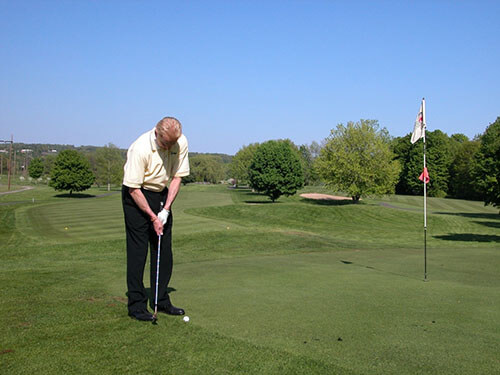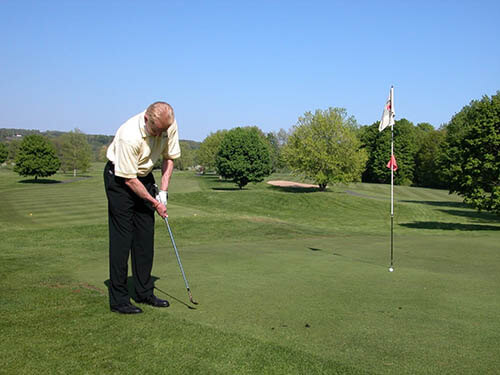Wild About the Wedge

by Dr. T.J. Tomasi A Legacy Post by Keiser University College of Golf Senior Faculty and Director of Research (1940-2023)
The challenge depicted in this week’s lesson is that my ball has run past the flag and is frozen against the fringe of the green, making it very difficult to contact the ball solidly with my putter because the “frog hair” that it lies against is as tall as the center of the ball. Even though I’m not far from the pin, the lie is just awkward enough to cause one of those head-shaking bogies that are so annoying. In this case, instead of using my putter, I’m using my sand wedge, but I’m not going to chip it — I’m going to use my putting stroke with a few key adjustments. I’ve chosen the sand wedge because it has a large flange on the bottom, and even though I plan to contact the ball with the leading edge of the club (the bottom edge), in case I miss, the flange will save me.
My goal is to make contact with the top half of the ball, the half that’s not obscured by the fringe. This will put a great deal of top spin on the ball that will send it farther than a normal stroke with a putter, so I don’t need to hit it as hard. A few practice putts before the round will clue you in as to how hard to hit it — something you should do regularly, especially if the course you’re playing has high fringe.
Putting With a Wedge
Putting with a wedge, particularly a sand wedge, can be a strategic choice for golfers in certain situations. The technique described is used by golfers when their ball is on the fringe or in light rough near the green. The ball position, in this example, might hinder and prevent a clean putt should the golfer choose to use a traditional putter. The taller or uneven grass causes a traditional putter to not perform as accurately and efficiently. To combat the conditions in this example, a wedge’s loft will help lift the ball, allowing it to clear obstacles like thick grass or minor imperfections in the fringe. In addition, using a wedge also reduces the risk of the clubface snagging on the ground, providing more control over the shot. Putting with a wedge can be beneficial on fast greens, where minimizing backspin and getting the ball rolling quickly is crucial. While unconventional, this method can be an effective tool for golfers to navigate challenging lies around the green.

Look how I play the ball off my front heel and utilize the putting grip on the wedge. Positioning the ball slightly forward in your stance to ensures clean contact. The, square the clubface to your target, just as you would with a putter. Keep your hands slightly ahead of the ball to encourage a downward strike, which helps lift the ball over any obstacles.

Once aligned and in position, I make a smooth, pendulum-like stroke, similar to a putt, with the wedge. During the follow through I make sure be short and controlled to allow the ball to roll smoothly.
Technique:
- Play the ball off your front heel to encourage contact on the upswing. You want to “top” this shot and produce over spin.
- Adjust your grip so that the wedge is the same length as your putter.
- Keep your hands on the same level from start to finish.
- Aim for a spot on the back of the ball near its top.
- Keep your wrists firm and quiet while you move the clubhead with a slight tilting action of your shoulders.
I’m using my putting grip with the wedge in these photos. Note how level my hands are before and after impact. This is the key to solid impact and a consistent roll.
Note: Practicing putting with your wedge is a great way to improve your stroke. If you get “handsy,” the feedback is immediate — the ball rolls like a wheel falling off the chuck wagon.
Practice Putting with a Wedge
Practicing putting with a wedge can be a useful skill for golfers to develop for tricky situations on the course. When you start, try practicing on different types of greens, focusing on smooth surfaces to build confidence. Use a short backswing and a controlled follow-through to keep the ball rolling smoothly. Try to practice from various distances to understand how the ball reacts when hitting off a wedge. Experiment with different grip pressures and stances to find what feels most comfortable for you. Practice hitting the ball just off the green to simulate real scenarios you could face on the course. Pay close attention to how the wedge interacts with the grass when you swing. Try adjusting your stroke accordingly based on what you see and feel. Finally, try to incorporate using a wedge to put into your regular practice routine to enhance your overall short game versatility.
WEDGE-O-NOMICS
Some things you ought to know about your wedges:
- The sand wedge is the heaviest club in your bag.
- Lie angles for wedges need not match the progression of lie angles in your iron set. If your irons are 2 degrees flat, your sand wedge can be standard.
- If you are exceptionally tall or short, or if you want to fill a distance gap, here’s a good rule of thumb: Bend wedges +/-2 degrees for loft and +3/-2 degrees for lie angle, but be careful. Some wedges are brittle and will snap easily.
- Ideal is 4 degrees of loft between your wedges. So, if you carry four wedges, your pitching wedge might be 48 degrees, the gap wedge 52, the sand wedge 56, and the lob wedge 60 degrees.
- If you bend a 54-degree wedge 2 degrees strong (less loft, lower flight, longer carry), it would then be a 52-degree wedge, and the bounce would decrease by 2 degrees. Just the opposite would happen if you take a 54-degree wedge and bend it 2 degrees weak (more loft, higher flight, shorter carry).
- When you open the clubface, you increase the effective bounce, so be careful on tight lies.
- New grooves can double the spin that worn-out grooves will give you.
- Make sure your wedge has channels built into the face to drain it of dirt and moisture. The newest design technology is the best.
Learn more!
Want more tips? If you want to take your game to the next level, contact our team at Keiser University’s College of Golf & Sport Management today. With our dedication and experience, we can elevate your game to new heights together. Give us a call today at 888-355-4465.














